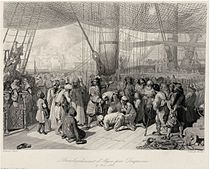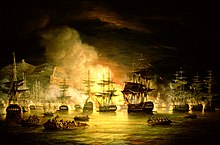A Phoenician commercial outpost called Ikosim which later developed into a small Roman town called Icosium existed on what is now the marine quarter of the city. The rue de la Marine follows the lines of what used to be a Roman street. Roman cemeteries existed near Bab-el-Oued and Bab Azoun. The city was given Latin rights by Vespasian. The bishops of Icosium are mentioned as late as the 5th century.

Old Algiers in the 16th century, with the Spanish-built Peñón of Algiers in the forefront.
The present-day city was founded in 944 by Bologhine ibn Ziri, the founder of the Berber Zirid–Sanhaja dynasty. He had earlier (935) built his own house and a Sanhaja center at Ashir, just south of Algiers. Although his Zirid dynasty was overthrown by Roger II of Sicily in 1148, the Zirids had already lost control of Algiers to their cousins the Hammadids in 1014.[4] The city was wrested from the Hammadids by the Almohades in 1159, and in the 13th century came under the dominion of the Ziyanid sultans of Tlemcen. Nominally part of the sultanate of Tlemcen, Algiers had a large measure of independence under amirs of its own due to Oran being the chief seaport of the Ziyanids.
As early as 1302 the islet of Peñón in front of Algiers harbour had been occupied by Spaniards. Thereafter, a considerable amount of trade began to flow between Algiers and Spain. However, Algiers continued to be of comparatively little importance until after the expulsion of the Moors from Spain, many of whom sought asylum in the city. In 1510, following their occupation of Oran and other towns on the coast of Africa, the Spaniards fortified the islet of Peñon and imposed a levy intended to suppress corsair activity.[5]
Ottoman rule

Abraham Duquesne delivering Christian captives in Algiers after the bombing in 1683.
In 1516, the amir of Algiers, Selim b. Teumi, invited the corsair brothers Aruj and Hayreddin Barbarossa to expel the Spaniards. Aruj came to Algiers, ordered the assassination of Selim, and seized the town and ousted the Spanish in the Capture of Algiers (1516). Hayreddin, succeeding Aruj after the latter was killed in battle against the Spaniards in the Fall of Tlemcen (1517), was the founder of the pashaluk, which subsequently became the beylik, of Algeria. Barbarossa lost Algiers in 1524 but regained it with the Capture of Algiers (1529), and then formally invited the Sultan Suleiman the Magnificent to accept sovereignty over the territory and to annex Algiers to the Ottoman Empire.
Algiers from this time became the chief seat of the Barbary pirates. In
October 1541 in the Algiers expedition, the King of Spain and Holy Roman
Emperor Charles V sought to capture the city, but a storm destroyed a
great number of his ships, and his army of some 30,000, chiefly made up
of Spaniards, was defeated by the Algerians under their Pasha, Hassan.

Historic map of Algiers by Piri Reis

The bombardment of Algiers by Lord Exmouth, August 1816, painted by Thomas Luny

Ornate Ottoman cannon
found in Algiers on 8 October 1581 by Ca'fer el-Mu'allim. Length:
385 cm, cal:178 mm, weight: 2910 kg, stone projectile. Seized by France
during the invasion of Algiers in 1830. Musée de l'Armée, Paris.
Formally part of the Ottoman Empire but essentially free from Ottoman
control, starting in the 17th century Algiers turned to piracy and
ransoming. Due to its location on the periphery of both the Ottoman and
European economic spheres, and depending for its existence on a
Mediterranean that was increasingly controlled by European shipping,
backed by European navies, piracy became the primary economic activity.
Repeated attempts were made by various nations to subdue the pirates
that disturbed shipping in the western Mediterranean and engaged in
slave raids as far north as Iceland.[6] The United States fought two wars (the First and Second Barbary Wars) over Algiers' attacks on shipping.
The city under Ottoman control was enclosed by a wall on all sides,
including along the seafront. In this wall, five gates allowed access to
the city, with five roads from each gate dividing the city and meeting
in front of the Ketchaoua Mosque. In 1556, a citadel was constructed at
the highest point in the wall. A major road running north to south
divided the city in two: The upper city (al-Gabal, or 'the mountain')
which consisted of about fifty small quarters of Andalusian, Jewish, Moorish and Kabyle
communities, and the lower city (al-Wata, or 'the plains') which was
the administrative, military and commercial centre of the city, mostly
inhabited by Turkish dignitaries and other upper-class families.[7]
In August 1816, the city was bombarded by a British squadron under Lord Exmouth (a descendant of Thomas Pellew, taken in an Algerian slave raid in 1715[citation needed]), assisted by Dutch men-of-war, destroying the corsair fleet harboured in Algiers.
French rule
The history of Algiers from 1830 to 1962 is bound to the larger history of Algeria and its relationship to France. On July 4, 1830, under the pretext of an affront to the French consul—whom the dey had hit with a fly-whisk when the consul said the French government was not prepared to pay its large outstanding debts to two Algerian merchants—a French army under General de Bourmont attacked the city in the 1830 invasion of Algiers. The city capitulated the following day. Algiers became the capital of French Algeria.
Many Europeans settled in Algiers, and by the early 20th century they formed a majority of the city's population.[8] During the 1930s, the architect Le Corbusier drew up plans for a complete redesign of the colonial city. Le Corbusier was highly critical of the urban style of Algiers, describing the European district as "nothing but crumbling walls and devastated nature, the whole a sullied blot". He also criticised the difference in living standards he perceived between the European and African residents of the city, describing a situation in which "the 'civilised' live like rats in holes" whereas "the 'barbarians' live in solitude, in well-being".[9] However, these plans were ultimately ignored by the French administration.
During World War II, Algiers was the last city to be seized from the Germans by the Allies during Operation Torch.

City and harbour of Algiers, c. 1921
In 1962, after a bloody independence struggle in which hundreds of thousands (estimates range between 500,000 to 1,500,000) died (mostly Algerians but also French and Pieds-Noirs) during fighting between the French Army and the Algerian Front de Libération Nationale, Algeria gained its independence, with Algiers as its capital. Since then, despite losing its entire pied-noir population, the city has expanded massively. It now has about five million inhabitants, or 10 percent of Algeria's population—and its suburbs now cover most of the surrounding Mitidja plain.
Algerian War

Coat of arms of Algiers during French colonization
Algiers also played a pivotal role in the Algerian War (1954–1962), particularly during the Battle of Algiers when the 10th Parachute Division of the French Army, starting on January 7, 1957, and on the orders of then French Minister of Justice François Mitterrand (who authorized any means "to eliminate the insurrectionists"[citation needed]), led attacks against the Algerian fighters for independence. Algiers remains marked by this battle, which was characterized by merciless fighting between Algerian forces who, on the one hand, resorted to attacking the French civilians and pro-French Algerians, and the French Army who, on the other, carried out a bloody repression including the quasi-systematic use of torture on protesters of the colonial order. The demonstrations of May 13 during the crisis of 1958 provoked the fall of the Fourth Republic in France, as well as the return of General de Gaulle to power.
Independence
Algeria achieved independence on July 5, 1962. Run by the FLN that had secured independence, Algiers became a member of Non-Aligned Movement during the Cold War. In October 1988, one year before the fall of the Berlin Wall, Algiers was the site of demonstrations demanding the end of the single party system and the creation of a real democracy baptized the “Spring of Algiers”. The demonstrators were repressed by the authorities (more than 300 dead), but the movement constituted a turning point in the political history of modern Algeria. In 1989, a new constitution was adopted that put an end to the reign of the single party and saw the creation of more than fifty political parties, as well as official freedom of the press.
Crisis of the 1990s
The city became the theatre of many political demonstrations of all descriptions until 1992. In 1991, a political entity dominated by religious conservatives called the Islamic Salvation Front engaged in a political test of wills with the authorities. In the 1992 elections for the Algerian National Assembly, the Islamists garnered a large amount of support in the first round, helped by a massive abstention from disillusioned Algerian voters by the turn of events. Fearing an eventual win by the Islamists, the army cancelled the election process, setting off a civil war between the State and armed religious conservatives which would last for a decade.
On December 11, 2007, two car bombs exploded in Algiers. One bomb targeted two United Nations buildings and the other targeted a government building housing the Supreme Court. The death toll is at least 62, with over two hundred injured in the attacks.[10] However, only 26 remained hospitalized the following day.[11] As of 2008, it is speculated that the attack was carried out by the Al Qaida cell within the city.[12]
Indigenous terrorist groups have been actively operating in Algeria since around 2002.



























































